The x86 Power Myth Busted: In-Depth Clover Trail Power Analysis
by Anand Lal Shimpi on December 24, 2012 5:00 PM ESTThe untold story of Intel's desktop (and notebook) CPU dominance after 2006 has nothing to do with novel new approaches to chip design or spending billions on keeping its army of fabs up to date. While both of those are critical components to the formula, its Intel's internal performance modeling team that plays a major role in providing targets for both the architects and fab engineers to hit. After losing face (and sales) to AMD's Athlon 64 in the early 2000s, Intel adopted a "no more surprises" policy. Intel would never again be caught off guard by a performance upset.
Over the past few years however the focus of meaningful performance has shifted. Just as important as absolute performance, is power consumption. Intel has been going through a slow waking up process over the past few years as it's been adapting to the new ultra mobile world. One of the first things to change however was the scope and focus of its internal performance modeling. User experience (quantified through high speed cameras mapping frame rates to user survey data) and power efficiency are now both incorporated into all architecture targets going forward. Building its next-generation CPU cores no longer means picking a SPECCPU performance target and working towards it, but delivering a certain user experience as well.
Intel's role in the industry has started to change. It worked very closely with Acer on bringing the W510, W700 and S7 to market. With Haswell, Intel will work even closer with its partners - going as far as to specify other, non-Intel components on the motherboard in pursuit of ultimate battery life. The pieces are beginning to fall into place, and if all goes according to Intel's plan we should start to see the fruits of its labor next year. The goal is to bring Core down to very low power levels, and to take Atom even lower. Don't underestimate the significance of Intel's 10W Ivy Bridge announcement. Although desktop and mobile Haswell will appear in mid to late Q2-2013, the exciting ultra mobile parts won't arrive until Q3. Intel's 10W Ivy Bridge will be responsible for at least bringing some more exciting form factors to market between now and then. While we're not exactly at Core-in-an-iPad level of integration, we are getting very close.
To kick off what is bound to be an exciting year, Intel made a couple of stops around the country showing off that even its existing architectures are quite power efficient. Intel carried around a pair of Windows tablets, wired up to measure power consumption at both the device and component level, to demonstrate what many of you will find obvious at this point: that Intel's 32nm Clover Trail is more power efficient than NVIDIA's Tegra 3.
We've demonstrated this in our battery life tests already. Samsung's ATIV Smart PC uses an Atom Z2760 and features a 30Wh battery with an 11.6-inch 1366x768 display. Microsoft's Surface RT uses NVIDIA's Tegra 3 powered by a 31Wh battery with a 10.6-inch, 1366x768 display. In our 2013 wireless web browsing battery life test we showed Samsung with a 17% battery life advantage, despite the 3% smaller battery. Our video playback battery life test showed a smaller advantage of 3%.

For us, the power advantage made a lot of sense. We've already proven that Intel's Atom core is faster than ARM's Cortex A9 (even four of them under Windows RT). Combine that with the fact that NVIDIA's Tegra 3 features four Cortex A9s on TSMC's 40nm G process and you get a recipe for worse battery life, all else being equal.
Intel's method of hammering this point home isn't all that unique in the industry. Rather than measuring power consumption at the application level, Intel chose to do so at the component level. This is commonly done by taking the device apart and either replacing the battery with an external power supply that you can measure, or by measuring current delivered by the battery itself. Clip the voltage input leads coming from the battery to the PCB, toss a resistor inline and measure voltage drop across the resistor to calculate power (good ol' Ohm's law).
Where Intel's power modeling gets a little more aggressive is what happens next. Measuring power at the battery gives you an idea of total platform power consumption including display, SoC, memory, network stack and everything else on the motherboard. This approach is useful for understanding how long a device will last on a single charge, but if you're a component vendor you typically care a little more about the specific power consumption of your competitors' components.
What follows is a good mixture of art and science. Intel's power engineers will take apart a competing device and probe whatever looks to be a power delivery or filtering circuit while running various workloads on the device itself. By correlating the type of workload to spikes in voltage in these circuits, you can figure out what components on a smartphone or tablet motherboard are likely responsible for delivering power to individual blocks of an SoC. Despite the high level of integration in modern mobile SoCs, the major players on the chip (e.g. CPU and GPU) tend to operate on their own independent voltage planes.
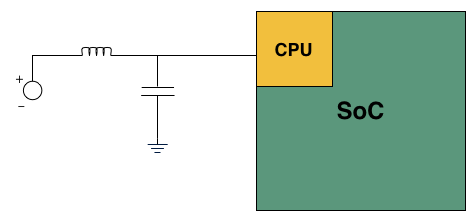
A basic LC filter
What usually happens is you'll find a standard LC filter (inductor + capacitor) supplying power to a block on the SoC. Once the right LC filter has been identified, all you need to do is lift the inductor, insert a very small resistor (2 - 20 mΩ) and measure the voltage drop across the resistor. With voltage and resistance values known, you can determine current and power. Using good external instruments you can plot power over time and now get a good idea of the power consumption of individual IP blocks within an SoC.
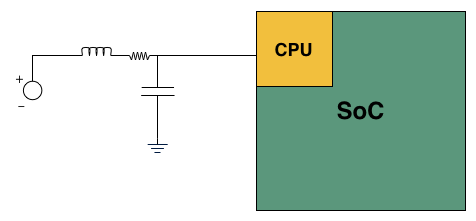
Basic LC filter modified with an inline resistor
Intel brought one of its best power engineers along with a couple of tablets and a National Instruments USB-6289 data acquisition box to demonstrate its findings. Intel brought along Microsoft's Surface RT using NVIDIA's Tegra 3, and Acer's W510 using Intel's own Atom Z2760 (Clover Trail). Both of these were retail samples running the latest software/drivers available as of 12/21/12. The Acer unit in particular featured the latest driver update from Acer (version 1.01, released on 12/18/12) which improves battery life on the tablet (remember me pointing out that the W510 seemed to have a problem that caused it to underperform in the battery life department compared to Samsung's ATIV Smart PC? it seems like this driver update fixes that problem).
I personally calibrated both displays to our usual 200 nits setting and ensured the software and configurations were as close to equal as possible. Both tablets were purchased by Intel, but I verified their performance against my own review samples and noticed no meaningful deviation. All tests and I've also attached diagrams of where Intel is measuring CPU and GPU power on the two tablets:

Microsoft Surface RT: The yellow block is where Intel measures GPU power, the orange block is where it measures CPU power
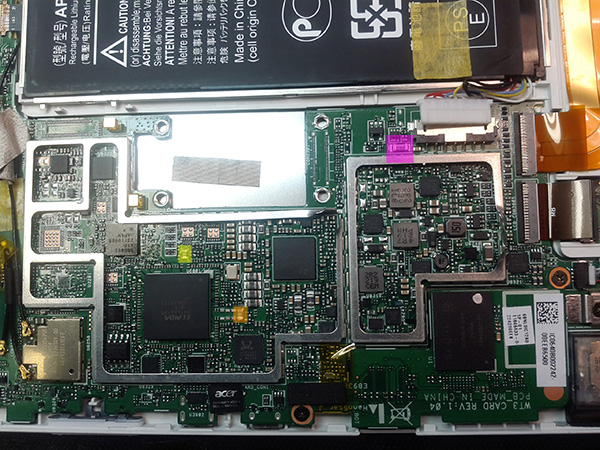
Acer's W510: The purple block is a resistor from Intel's reference design used for measuring power at the battery. Yellow and orange are inductors for GPU and CPU power delivery, respectively.
The complete setup is surprisingly mobile, even relying on a notebook to run SignalExpress for recording output from the NI data acquisition box:
Wiring up the tablets is a bit of a mess. Intel wired up far more than just CPU and GPU, depending on the device and what was easily exposed you could get power readings on the memory subsystem and things like NAND as well.
Intel only supplied the test setup, for everything you're about to see I picked and ran whatever I wanted, however I wanted. Comparing Clover Trail to Tegra 3 is nothing new, but the data I gathered is at least interesting to look at. We typically don't get to break out CPU and GPU power consumption in our tests, making this experiment a bit more illuminating.
Keep in mind that we are looking at power delivery on voltage rails that spike with CPU or GPU activity. It's not uncommon to run multiple things off of the same voltage rail. In particular, I'm not super confident in what's going on with Tegra 3's GPU rail although the CPU rails are likely fairly comparable. One last note: unlike under Android, NVIDIA doesn't use its 5th/companion core under Windows RT. Microsoft still doesn't support heterogeneous computing environments, so NVIDIA had to disable its companion core under Windows RT.


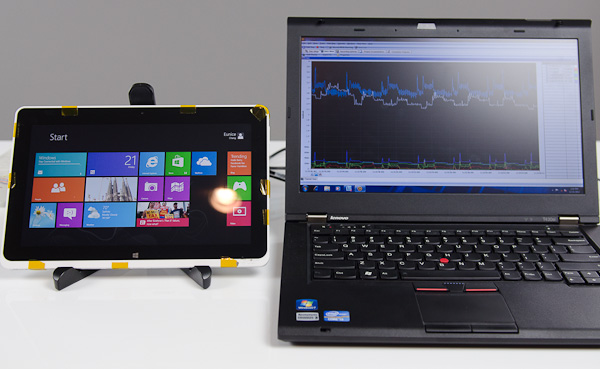
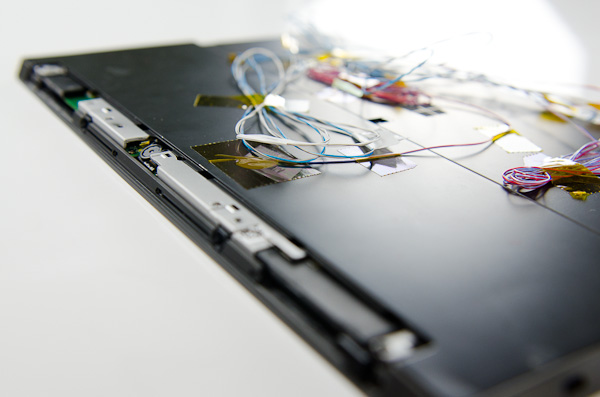
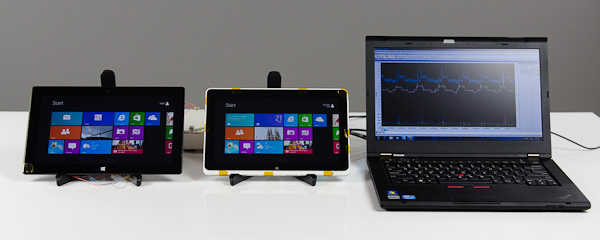














163 Comments
View All Comments
mrdude - Friday, December 28, 2012 - link
On the same Clover Trail Atom that has trouble keeping a fluid scrolling motion in Metro? The same Atom that's only 32-bit with 2GB RAM on the devices? The same Atom that can't run your legacy productivity software any better than the old netbooks?The x86 legacy requirements are going to be significantly higher than the ARM parts due to the software the x86 chips are required to run. If you can't run CAD or Photoshop or Blender, or any other useful productivity application on your tablet/notebook, then you likely don't need x86 in the first place. All of the other applications that don't require that much horsepower already have alternatives, and often better alternatives, in the iOS and Android app stores.
If I can't run the same games and demanding software on an x86 tablet, then do I really need an x86 tablet?
That's the dilemma Intel and Microsoft both face. Currently, the sales figures of these x86 tablets are less than 1% of all Win8 devices thus far sold. People aren't going to pay a higher price just because it says Microsoft or Intel on it. Given the robustness of Google Play and iOS App stores and the market penetration of those respective devices, the majority of the same crowd that's buying tablets is likely to be just as familiar with Android and iOS as they are with Windows. In fact, perhaps even more so given the dramatic UI changes to Win8. If people need Office they won't have to wait long because Microsoft announced it was offering an Android and iOS version of Microsoft Office in the Spring of 2013.
x86 compatibility looks great until you realize just how much you're missing out on with respect to the Android and iOS app stores. And if I'm going to buy a tablet for work then I'm sure as hell going to demand that it actually has enough power to run my software. Otherwise what's the point? A weak x86 tablet that can't run productivity software and games is just a tablet that's missing out on both ends.
CeriseCogburn - Friday, January 25, 2013 - link
Worse than that, who wants to switch to the awful faded out rectal-boxed sick pastels of msft 8 with their crappy harder to identify the "icon box" from heck UI?pugster - Thursday, December 27, 2012 - link
Intel probably got their best cpu against ARM's worst cpu in an operating system that might not be optimized for ARM. I personally would like to see if Intel would start outfitting these cpu's in android tablets and with more optimized arm cpu's like cortex a7/15.ddriver - Friday, December 28, 2012 - link
I bet Intel ordered and paid for this article, potentially providing guidelines how and against what product to be tested.It is shameful for Intel to miss out on mobile platforms. Surely, low profit margin is not Intel's territory to begin with, but still, the rise of popularity of ARM devices represents a substantial blow to the reputation and monopoly of Intel - the world has seen there is more to the market than Intel (and poor perpetual runner up AMD). It is a long term threat, as indirect as it may be.
A15 is pretty much here and a dual A15 is about twice as fast as a quad A9. The Atom is competitive to current aging ARM designs, but it will slip back as soon as A15 designs flood the market.
x86 and CISC in general are something that should have died out a long time ago, but its life was artificially prolonged, because no one in the industry really gives a damn about efficiency. Efficiency is the enemy of profit, and profit is the sole motivation for everything being done nowadays.
Don't get me wrong, the overheads of CISC are insignificant, and Intel will probably be able to make up for it with better in-house manufacturing process. And with such a hefty profit margin on their middle to high end, they can afford to give low power CPUs for free to big players, just to kill a potential long term threat to their business. It won't be the first time Intel will pay to cripple its competition.
x86 is crippled by licensing, while anyone is free to license ARM and do his own spin - big companies like Samsung have the capacity to design and manufacture an ARM based CPU according to their needs, which is something Intel won't be bothered with. Selling entire early batches exclussively to Apple to put in their useless toys first is an entirely different matter from doing customizations to the actual hardware and production lines just to please a client.
The sooner the world moves away from x86 the sooner we will see some actual competition, instead of this MONOPOLY in the disguise of a duopoly we have today. I do run an Intel rig, because I need the performance, but I am no fan of Intel, or of the amount of money I had to pay for it because Intel has no competition and does whatever it wants. I'd happily watch the company burn to the ground, the world doesn't need a greedy monopolistic entity - it is that entity that needs the world to suck the wealth out of it.
nofumble62 - Saturday, December 29, 2012 - link
skip that software incompatibility nonsense.ddriver - Saturday, December 29, 2012 - link
Due to the horrendous (at least compared to ARM cores) power consumption, this is only possible with a significantly big battery, which would make the tablet experience almost the same as if were a stone tablet.Software incompatibility - you can thank Microsoft for this, they have pushed their vendor and platform limited development tools for so long. That is why I ditched any MS related technology, I still use windows, but I don't code against the MS APIs, instead I use Qt - the same code runs on Windows, Mac, Linux and very soon iOS and Android will be officially supported too (right now those are only unofficially supported).
Big companies like Adobe and Autodesk have already embraced Qt in their workflow, but it will still take some time to shake off the MS legacy crap from their code base.
Sure, you can go for something lame and inefficient like Java or HTML+JavaScript, but nothing beats the performance and memory efficiency of native machine code.
Pazz - Saturday, December 29, 2012 - link
The fundamental point which should be highlighted throughout this entire analysis is that Clovertrail is significantly newer tech than Tegra 3.The Tegra 3 inside the MS Surface had availability as soon as Q4 2011.
Microsofts choice to implement the Tegra 3 SOC was a matter of timing. It was the best available to the Surface team at the time. The extensive development of a new product, particularly as important as Surface given the current market and timing with Win8, always tends to result in older tech being included. More time is invested in other non-SOC specific areas.
theSuede - Sunday, December 30, 2012 - link
A very well executed run-through, but:Wouldnt it be possible to do a measurement sample floating average over five samples or something? The charts are close to unreadable, and the graphical presentation fools the eye into averaging sample points incorrectly.
Spikes in graphs are only averageable by human vision in point charts, in line charts the eye puts far to much weight on local deviations.
The same goes for most storage/HD performance graphs at AnandTech. Just my 5c on statistics presentation interpretation...
casper.bang - Tuesday, January 1, 2013 - link
I'm a little confused about what this article is trying to tell; looks to me as if Anand is comparing next-gen Intel Atom with current-gen ARM A9 and by doing so arrives at the *shocking* conclusion that the former is more performance/power efficient... and adds a sensational headline to top it off?!I honestly expected a bit more; say focus on Cortex A15 vs. Hashwell. I'm also surprised at the lack of a discussion about how Intel is possibly lowering wattage, considering they are infamous for solving problems in the past decade by throwing on clunky power-hungry caches.
Clearly Intel has some brilliant engineers and world-class manufacturing, but should we not wait to compare apples to apples before declaring that "x86's high power-consumption is a myth"? Come again when routers, picture frames, media centers, tablets, phones etc. based on x86 is mainstream rather than a wet dream in Otellini's head.
Kidster3001 - Friday, January 4, 2013 - link
You mean the 5 year old Clovertrail core design... designed before Tegra3? THAT next-gen Atom?